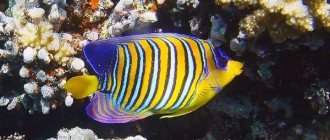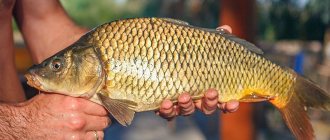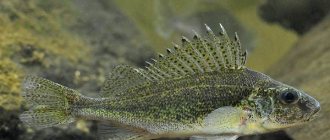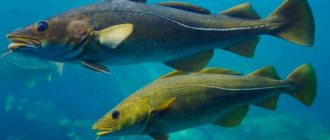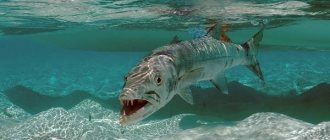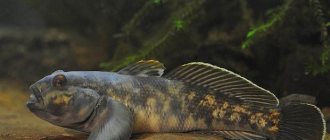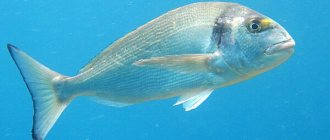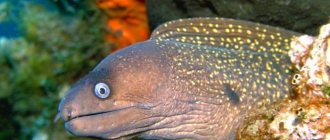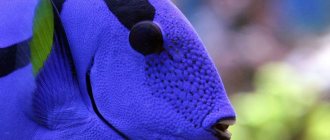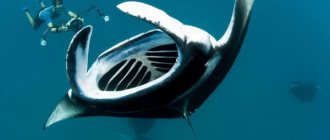The barrel-eyed fish is a little-studied inhabitant of the depths with a transparent head. She looks more like a traveler from a parallel galaxy. Macropinna barrel eye is the oldest inhabitant of the depths of the oceans. But it became famous even among researchers quite recently. Nature had to take care of preserving this unusual creature. She was able to save the barrel-eye from the destructive effect exerting pressure of hundreds of atmospheres, and taught her to survive amid the lack of oxygen in the freezing cold of the sea depths.
Have you ever been attacked by a fish?
Yes
20%
No
80%
Voted: 10
Features and habitat
Macropinna is a mysterious fish of the ocean depths. Macropinna microstoma is a small fish and, even in the rarest cases, its size does not exceed 15 cm. Dark scales cover the main part of the body of such a creature, which spends its life in the depths of the ocean.
In the photo of macroninna , examining its contours, rounded, wide and large fins are clearly visible. The fish's eyes are tubular, its throat is impressive, and its mouth is narrow. This inhabitant of the waters, otherwise called the smallmouth macropinna, was discovered and described in the last century.
But only at the beginning of this year were it possible to obtain photographs of mysterious creatures that revealed the secret of the unique details of their structure. The peculiarity is that the head of such a fish is transparent, which is not typical for any creature in this world.
It is interesting to note that such a fact was not so easy to find out earlier, since there was no equipment yet that clearly reflected the details of the appearance of creatures living at great depths. And the translucent fragile dome that nature endowed this living organism with was immediately destroyed the moment the fish was removed from the water.
Top view of macropinna fish
Through the transparent forehead of such an almost fantastic creature, one can somehow see the internal structure. The most interesting element of its structure is, first of all, its impressive unique eyes, located in a reservoir filled with a special liquid, but not outside, like in ordinary earthly creatures, but inside the body.
And on the surface of the transparent dome of the fish there are only olfactory organs that detect various changes in the surrounding world. Macropinna is a representative of the class of ray-finned fish, distributed in temperate latitudes and subtropics, found in the northern hemisphere in the depths of the Pacific Ocean and, adjacent to it, the waters of the Bering Strait and the Sea of Okhotsk.
Such creatures are also found within the waters of Kamchatka and Japan, in the depths of waters reaching the coast of Canada. In the opisthoproctaceae family, to which these living organisms belong, today, according to scientists, there are about a dozen species.
Description of the barrel-eyed macropinna
Discovered, described in detail and classified closer to 1940 by scientist Chapman.
The fish belongs to: species - deep-sea ray-finned fish, family Opisthoproctaceae, genus Macropinna, order Smeltfish.
The barrel-eyed fish is the only representative of the genus Macropinna, allocated to the opisthoproctaceae family.
Its repeatedly noted feature is its transparent head, which helps it observe potential prey and possible danger with its barrel-shaped eyes. The head, through which the barrel eye monitors what is happening in the not-so-friendly marine environment, protects its eyes.
Retrieving smallmouth macropinna for surface study was a problematic issue. When the pressure changes, her body was torn apart. All the insides took the form of jelly. The fish was often mistaken for an incomprehensible piece of mucus, and then for an ordinary plastic bag.
Yandex pictures
Character and lifestyle
This animal has another name - the barrel eye for the corresponding structure of the tube-shaped organs of vision, which turn out to be very useful in the environment where the life of fish takes place, living in the ocean depths under a water column of five to eight hundred meters.
The sun's rays penetrate little into these remote areas, which left an imprint on the visual perception of underwater creatures, capable of perceiving even in pitch darkness. Light entering the eyes of the fish lights them up with a bright green color. The reason for this phenomenon is a special substance that filters light rays.
This is considered another interesting fact , but the smallmouth macropinna is such a mysterious creature that with its in-depth study of the secrets it only becomes greater. Fantastic inhabitants of distant depths never cease to amaze scientists, but this is understandable, because these are creatures far from civilization and the property of a completely different world.
It is difficult for a person to remain in their inaccessible and dangerous habitat, and they cannot exist in our world. At great depths, where they are used to living, even the pressure is completely different. That is why, if you take such fish out of the water, the fragile frontal part of their head bursts from its drop.
The structure of the fish's fins is also an excellent adaptation for comfortable swimming and impressive maneuvers in deep ocean waters. However, it cannot be said that such creatures exhibit high vital activity. They are quite slow, and when swimming, they often stop and freeze in one place.
Do these almost fantastic animals have enemies? Science does not yet know enough about this, because observing the details of the movement and lifestyle of these fish in the depths of the ocean is very difficult.
Smallmouth macropinna
Their paths do not intersect with the paths of man. And there is no need for them to intersect. The inhabitants of the depths do not care about people, and for people, other than curiosity and a thirst for knowledge, there is no practical benefit for the stomach from them either. The peculiarities of their anatomy make it difficult for humans to eat such creatures.
Description of the smallmouth macropinna
Macropinna smallmouth is a small fish. Its largest specimens were found with a body size of up to 15 cm. The body of this fish is wide and rounded. It is covered with dark scales from the tail to the head. Its most unusual organ is its head, which is dome-shaped and completely transparent. In the middle of the head there are large and round green eyes. Between the eyes of this fish there is a thin membrane of bone that expands backwards and extends. The expanded part contains the fish's brain. In front of the head there are 2 depressions that may resemble eyes, but in reality they are macropinnae smell receptors.
The eyes of this fish became bright green due to the presence of a special yellow pigment in them. Scientists say that due to this pigment, the macropinna reduces the brightness of the light that comes from above. In addition, with such pigments, macropinna can detect and distinguish the bioluminescence of its prey.
Nutrition
The slowness of the smallmouth macropinna , a fish with a transparent head , does not prevent it from being a successful hunter. Having special barrel-shaped eyes located inside the head and protected by a transparent shell, such creatures are able to perceive the world around them, both horizontally and vertically, which allows them to conduct successful observations of the intended prey and not miss any of the details of its movements.
If the victim has the temerity to swim closer to such a big-eyed enemy, he immediately finds himself caught, meeting his sad end. During the day, such fish make regular movements, rising, although not long distances, to the upper layers of water, where they get their food, and at night they descend back.
It is not difficult to understand that aquatic hunters are predators. But they are not interested in big prey. Due to the presence of a small mouth (for which the fish received the name smallmouth), they are able to feed mainly on plankton, siphonophore tentacles, crustaceans and other small animal organisms.
Fish with transparent head
Despite the fact that the smallmouth macropinna (lat. Macropinna microstoma) was discovered back in 1939, it was only recently possible to study it. Previously, when examining the transparent head of this deep-sea fish, scientists could not figure out how it sees prey, because its gaze must always be directed upward.
In fact, those specimens that meticulous researchers came across were severely injured when rising to the surface. Only 70 years later, in 2009, the world was able to see photographs of a living macropinna. At the same time, the structure of the eye of this unique underwater inhabitant became known.
And the visual organs of the smallmouth macropinna are cylindrical in shape, for which it was nicknamed the barrel eye. The transparent periocular bones, together with the elastic covering membrane, provide their protection. It was this shell that was lost when the unfortunate fish fell into the net and was thrown out at the stern of the ship.
The eyes themselves are located in a chamber filled with a special liquid. They are separated by a bony septum, which also houses the brain. True, for this it is slightly extended back and expanded.
At first glance at a photograph of a macropinna, it may seem that the fish has eye holes that are located directly above the mouth. These are actually the olfactory organs—large, rounded pockets containing olfactory receptor arrays. The barrel eye has a large throat and a small mouth, so it cannot catch large prey.
The fish itself is small - up to 15 cm in length. Her entire body, except her head, is covered with dark scales. The rounded fins are quite large. It is they who help the macropinna remain practically motionless, hovering in the water column. At the same time, she holds her pectoral fins horizontally, and tilts her abdominal fins at an angle of 30 degrees. At the slightest danger, the barrel eye quickly presses all its fins to its body and swims away with the help of sharp beats of its tail.
These unusual fish live in the north of the Pacific Ocean, preferring its temperate and subarctic waters. They were most often found off the coast of Japan and the Kuril Islands, as well as in the Bering Sea, near the western coasts of the USA and Canada and south to the Gulf of California. Smallmouth macropinna loves depths from half a thousand to 800 meters. Moreover, the more meters from the surface of the water, the larger the size of the fish itself.
The barrel eye feeds on various zooplankton: small crustaceans, cnidarians, and also swallows siphonophores directly along with their cnidocytes. The fish hunts in two ways: it either waits until the prey descending down is at mouth level and grabs it, or it itself raises its head up to catch the prey swimming above its head. Her peculiar eyes, which either look up or are directed horizontally, help her a lot in this.
Scientists suggest that the macropinna acquired a transparent shell as a result of evolution as protection from cnidocyte siphonophores. Cnidocytes are a kind of stingers that siphonophores use to attack enemies and protect themselves from predators. Obviously, in the case of the barrel eye, this weapon was not very effective.
Reproduction and lifespan
Macropinna is fish , as already mentioned. Scientists are just beginning to learn the unique details of the lifestyle of these creatures that live deep at the bottom of the ocean. The same applies to methods of fish reproduction, about which not much is understood.
But it is known for certain that females of amazing fish spawn in large quantities. And the fry that emerge from it first have an elongated body, having little resemblance to their parents. But then numerous metamorphoses begin to occur to them, until they take on the natural appearance of adults.
The difficulty of observing deep-sea animals step by step throughout their entire life was a consequence of the fact that its duration is another mystery for scientists. And keeping in an aquarium, due to the anatomical features of such incomprehensible, little-studied, specially structured organisms, is very difficult and problematic.
However, these mysterious representatives of the fauna were still able to be placed and successfully kept in an aquarium located in California. The structure, which has become the new home of the mysterious fish, is considered one of the largest in the world, and houses many amazing species of aquatic fauna in 93 tanks.
And every day millions of curious spectators have the opportunity to observe amazing, fantastic and unique creatures. Therefore, we can hope that soon all the secrets of the macropinna will be revealed.
